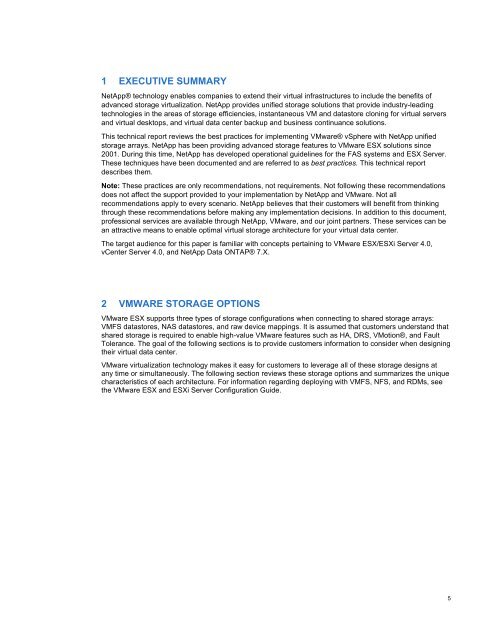NetApp and VMware vSphere Storage Best Practices
NetApp and VMware vSphere Storage Best Practices
NetApp and VMware vSphere Storage Best Practices
You also want an ePaper? Increase the reach of your titles
YUMPU automatically turns print PDFs into web optimized ePapers that Google loves.
1 EXECUTIVE SUMMARY<br />
<strong>NetApp</strong>® technology enables companies to extend their virtual infrastructures to include the benefits of<br />
advanced storage virtualization. <strong>NetApp</strong> provides unified storage solutions that provide industry-leading<br />
technologies in the areas of storage efficiencies, instantaneous VM <strong>and</strong> datastore cloning for virtual servers<br />
<strong>and</strong> virtual desktops, <strong>and</strong> virtual data center backup <strong>and</strong> business continuance solutions.<br />
This technical report reviews the best practices for implementing <strong>VMware</strong>® <strong>vSphere</strong> with <strong>NetApp</strong> unified<br />
storage arrays. <strong>NetApp</strong> has been providing advanced storage features to <strong>VMware</strong> ESX solutions since<br />
2001. During this time, <strong>NetApp</strong> has developed operational guidelines for the FAS systems <strong>and</strong> ESX Server.<br />
These techniques have been documented <strong>and</strong> are referred to as best practices. This technical report<br />
describes them.<br />
Note: These practices are only recommendations, not requirements. Not following these recommendations<br />
does not affect the support provided to your implementation by <strong>NetApp</strong> <strong>and</strong> <strong>VMware</strong>. Not all<br />
recommendations apply to every scenario. <strong>NetApp</strong> believes that their customers will benefit from thinking<br />
through these recommendations before making any implementation decisions. In addition to this document,<br />
professional services are available through <strong>NetApp</strong>, <strong>VMware</strong>, <strong>and</strong> our joint partners. These services can be<br />
an attractive means to enable optimal virtual storage architecture for your virtual data center.<br />
The target audience for this paper is familiar with concepts pertaining to <strong>VMware</strong> ESX/ESXi Server 4.0,<br />
vCenter Server 4.0, <strong>and</strong> <strong>NetApp</strong> Data ONTAP® 7.X.<br />
2 VMWARE STORAGE OPTIONS<br />
<strong>VMware</strong> ESX supports three types of storage configurations when connecting to shared storage arrays:<br />
VMFS datastores, NAS datastores, <strong>and</strong> raw device mappings. It is assumed that customers underst<strong>and</strong> that<br />
shared storage is required to enable high-value <strong>VMware</strong> features such as HA, DRS, VMotion®, <strong>and</strong> Fault<br />
Tolerance. The goal of the following sections is to provide customers information to consider when designing<br />
their virtual data center.<br />
<strong>VMware</strong> virtualization technology makes it easy for customers to leverage all of these storage designs at<br />
any time or simultaneously. The following section reviews these storage options <strong>and</strong> summarizes the unique<br />
characteristics of each architecture. For information regarding deploying with VMFS, NFS, <strong>and</strong> RDMs, see<br />
the <strong>VMware</strong> ESX <strong>and</strong> ESXi Server Configuration Guide.<br />
5


